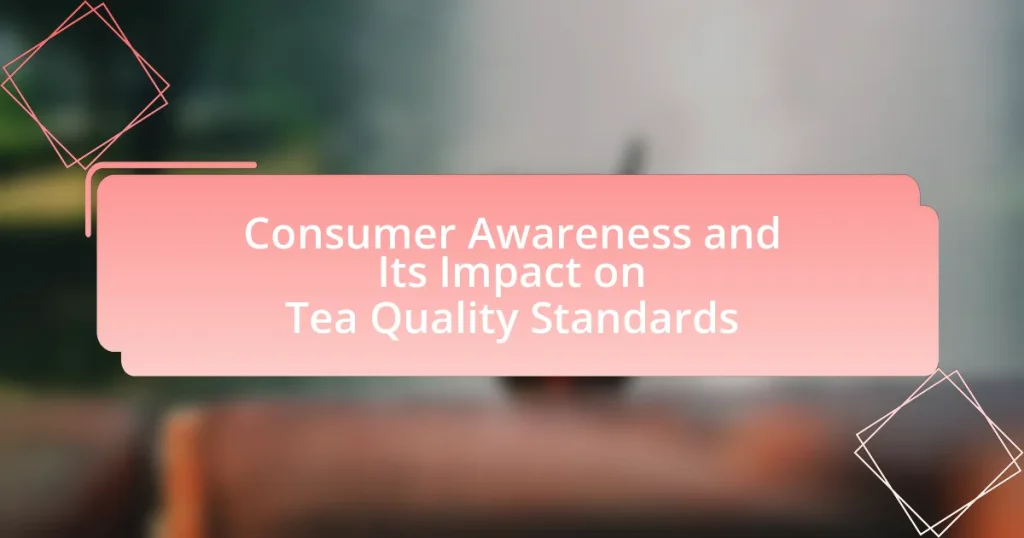Consumer awareness is the understanding and knowledge that individuals possess regarding their rights and the quality standards of the products they purchase, particularly in the tea industry. This awareness significantly influences tea quality standards by driving demand for higher quality and ethically sourced products, as informed consumers tend to prefer brands that adhere to organic and fair-trade certifications. Key factors shaping consumer awareness include product quality, branding, health benefits, and sustainability practices. The article explores how consumer demand impacts tea production, the challenges consumers face in understanding quality standards, and the role of education and transparency in enhancing consumer knowledge about tea quality. Additionally, it examines regional differences in tea quality standards and the emerging trends in consumer preferences towards organic and sustainably sourced teas.

What is Consumer Awareness and Its Impact on Tea Quality Standards?
Consumer awareness refers to the understanding and knowledge that consumers have regarding their rights, the products they purchase, and the standards associated with those products. This awareness significantly impacts tea quality standards by driving demand for higher quality and safer tea products. When consumers are informed about the health benefits, sourcing practices, and quality indicators of tea, they are more likely to choose products that meet stringent quality standards. For instance, a study published in the Journal of Consumer Research found that informed consumers are more likely to support brands that adhere to organic and fair-trade certifications, which often correlate with higher quality tea. This consumer behavior encourages producers to maintain and improve quality standards to meet market expectations.
How does consumer awareness influence tea quality standards?
Consumer awareness significantly influences tea quality standards by driving demand for higher quality products and encouraging transparency in production practices. When consumers are informed about the health benefits of tea and the importance of sustainable farming, they tend to prefer brands that adhere to strict quality guidelines and ethical sourcing. For instance, a study published in the Journal of Consumer Research found that consumers are willing to pay a premium for organic and fair-trade certified teas, which directly impacts producers to enhance their quality standards to meet this demand. This shift not only elevates the overall quality of tea available in the market but also promotes better agricultural practices among growers.
What are the key factors that shape consumer awareness in the tea industry?
Key factors that shape consumer awareness in the tea industry include product quality, branding, health benefits, and sustainability practices. Product quality influences consumer perceptions, as high-quality tea often leads to positive reviews and repeat purchases. Branding plays a crucial role, with established brands typically enjoying greater consumer trust and recognition. Health benefits associated with tea, such as antioxidants and potential disease prevention, significantly impact consumer choices, as evidenced by studies showing increased demand for health-oriented products. Lastly, sustainability practices, including ethical sourcing and environmentally friendly packaging, resonate with consumers increasingly concerned about environmental impact, thereby enhancing brand loyalty and awareness.
How does consumer demand affect the quality of tea products?
Consumer demand significantly influences the quality of tea products by driving producers to meet higher standards and preferences. When consumers prioritize quality, tea producers are compelled to adopt better agricultural practices, invest in superior processing techniques, and ensure stringent quality control measures. For instance, a study by the International Tea Committee indicates that regions with high consumer demand for premium tea, such as specialty and organic varieties, often see improvements in cultivation methods and product consistency. This correlation between demand and quality is evident as producers strive to satisfy consumer expectations, leading to enhanced flavor profiles and overall product excellence.
Why is consumer awareness important for tea quality?
Consumer awareness is crucial for tea quality because it empowers consumers to make informed choices about the products they purchase. When consumers are knowledgeable about tea quality indicators, such as origin, processing methods, and health benefits, they can demand higher standards from producers. This demand encourages manufacturers to prioritize quality over quantity, leading to improved agricultural practices and better product offerings. For instance, a study by the International Tea Committee highlights that regions with informed consumers tend to produce higher quality tea, as producers respond to consumer preferences for premium products.
What role does consumer education play in improving tea quality?
Consumer education plays a crucial role in improving tea quality by empowering consumers to make informed choices about the products they purchase. When consumers are educated about the characteristics of high-quality tea, such as flavor profiles, sourcing practices, and production methods, they are more likely to demand better standards from producers. This increased demand encourages tea producers to adopt higher quality practices, as they seek to meet consumer expectations. Research indicates that informed consumers can drive market trends, leading to improved agricultural practices and sustainability efforts within the tea industry. For instance, studies have shown that consumer awareness of ethical sourcing has led to a rise in demand for organic and fair-trade teas, prompting producers to enhance their quality standards to remain competitive.
How can informed consumers drive better practices in tea production?
Informed consumers can drive better practices in tea production by demanding transparency and sustainability from producers. When consumers prioritize ethically sourced and environmentally friendly tea, they encourage producers to adopt better agricultural practices, such as organic farming and fair labor conditions. Research indicates that consumer preferences significantly influence market trends; for instance, a 2020 survey by the Ethical Tea Partnership found that 70% of consumers are willing to pay more for sustainably produced tea. This financial incentive compels producers to improve their practices to meet consumer expectations, ultimately leading to higher quality standards in tea production.
What challenges do consumers face in understanding tea quality standards?
Consumers face several challenges in understanding tea quality standards, primarily due to a lack of standardized labeling and varying definitions of quality across different regions. The absence of universally accepted criteria makes it difficult for consumers to compare products effectively. Additionally, many consumers lack knowledge about the specific indicators of quality, such as leaf grade, aroma, and flavor profiles, which can lead to confusion when selecting tea. Research indicates that only 30% of consumers can accurately identify high-quality tea based on these factors, highlighting the gap in consumer education regarding tea standards.
What misinformation exists about tea quality that consumers should be aware of?
Misinformation about tea quality includes the belief that all expensive teas are of high quality and that all cheap teas are of low quality. This misconception overlooks the fact that tea quality is determined by factors such as the processing method, the region of cultivation, and the specific tea variety, rather than solely by price. For instance, high-quality teas can be produced in regions with lower production costs, while some expensive teas may be overpriced due to branding rather than quality. Additionally, consumers often assume that all organic teas are superior, but organic certification does not guarantee better flavor or quality; it simply indicates that no synthetic pesticides were used. Understanding these nuances helps consumers make informed choices about tea quality.
How can consumers identify high-quality tea products?
Consumers can identify high-quality tea products by examining several key factors, including the origin, appearance, aroma, and packaging of the tea. High-quality teas often come from specific regions known for their tea production, such as Darjeeling in India or Uji in Japan, which are recognized for their unique flavors and cultivation methods.
The appearance of the tea leaves is also crucial; high-quality teas typically feature whole, unbroken leaves with vibrant colors, indicating freshness and proper processing. Additionally, the aroma should be rich and fragrant, as this is a sign of the tea’s quality and freshness.
Packaging plays a significant role as well; high-quality teas are often packaged in airtight containers that protect them from light and moisture, preserving their flavor and aroma. Furthermore, reputable brands often provide information about the tea’s origin, harvest date, and processing methods, which can help consumers make informed choices.
By considering these factors, consumers can effectively identify high-quality tea products that meet their preferences and standards.

How do tea quality standards vary across different regions?
Tea quality standards vary significantly across different regions due to factors such as climate, cultivation practices, and local regulations. For instance, in China, the standards are often defined by specific regional classifications like Longjing or Tieguanyin, which emphasize traditional methods and flavor profiles. In contrast, Indian tea standards, particularly in Assam and Darjeeling, focus on the elevation and specific harvest periods, leading to distinct taste characteristics recognized by the Tea Board of India. Furthermore, countries like Japan have stringent quality control measures, including grading systems based on leaf appearance and aroma, which are integral to their tea culture. These regional differences reflect not only agricultural practices but also consumer preferences and market demands, influencing how tea is produced and marketed globally.
What are the main regional differences in tea quality standards?
The main regional differences in tea quality standards are primarily observed between Asia, Africa, and the Americas. In Asia, particularly in countries like China and Japan, tea quality is often assessed based on traditional methods, including leaf appearance, aroma, and taste, with strict adherence to historical cultivation practices. For instance, Chinese teas such as Longjing are evaluated for their specific grades, which are influenced by factors like harvest time and processing techniques.
In Africa, particularly in countries like Kenya and Malawi, tea quality standards focus more on yield and commercial viability, often prioritizing mass production over traditional quality indicators. The Kenyan Tea Development Agency emphasizes uniformity and high production standards, which can sometimes compromise the nuanced flavors found in smaller, artisanal batches.
In the Americas, particularly in regions like Argentina and the United States, tea quality standards are still developing, with a growing emphasis on organic and sustainable practices. American tea producers often highlight certifications such as USDA Organic, which reflect consumer awareness and demand for quality and sustainability.
These regional differences are influenced by cultural preferences, historical practices, and market demands, shaping how tea quality is perceived and regulated across different areas.
How do cultural preferences influence tea quality standards in different regions?
Cultural preferences significantly influence tea quality standards across different regions by shaping consumer expectations and defining desirable characteristics. For instance, in China, the emphasis on traditional tea ceremonies elevates the importance of flavor complexity and aroma, leading to stringent quality assessments based on these attributes. Conversely, in Western markets, where convenience and packaging often take precedence, quality standards may prioritize shelf life and branding over flavor nuances. This divergence is supported by research indicating that cultural context directly affects consumer perceptions of quality, as seen in studies by the International Tea Committee, which highlight varying consumer preferences and their impact on market standards.
What regulatory frameworks exist to ensure tea quality in various countries?
Regulatory frameworks ensuring tea quality vary by country and include specific standards and certifications. In India, the Tea Board regulates quality through the Tea (Marketing) Control Order, which mandates grading and labeling standards. In China, the National Standard for Tea (GB/T 13736) outlines quality parameters, including sensory evaluation and chemical composition. The European Union enforces regulations such as Regulation (EU) No 1169/2011, which requires accurate labeling and safety standards for food products, including tea. The United States has the Food and Drug Administration (FDA) overseeing tea quality through the Federal Food, Drug, and Cosmetic Act, which sets safety and labeling requirements. These frameworks collectively aim to protect consumer interests and ensure the quality of tea products in their respective markets.
How do consumer preferences shape regional tea quality standards?
Consumer preferences significantly influence regional tea quality standards by driving producers to meet specific taste, aroma, and appearance criteria. As consumers increasingly demand high-quality, unique flavors and sustainable sourcing, tea producers adapt their cultivation and processing methods to align with these preferences. For instance, regions known for premium teas, such as Darjeeling in India, have established strict quality standards to maintain their reputation and meet consumer expectations, which include factors like leaf size, color, and the presence of specific flavor notes. This alignment between consumer demand and production practices ensures that regional tea quality standards evolve in response to market trends, ultimately enhancing the overall quality and diversity of tea offerings.
What trends are emerging in consumer preferences for tea quality?
Emerging trends in consumer preferences for tea quality indicate a significant shift towards organic and sustainably sourced products. Consumers increasingly prioritize health benefits, leading to a demand for teas that are free from pesticides and artificial additives. According to a 2022 survey by the Tea Association of the USA, 70% of tea drinkers expressed a preference for organic options, reflecting a growing awareness of health and environmental impacts. Additionally, there is a rising interest in specialty teas, such as single-origin and artisanal blends, which offer unique flavors and traceability, further emphasizing quality over quantity. This trend is supported by market research from Grand View Research, which projects that the global organic tea market will grow at a CAGR of 10.5% from 2021 to 2028, underscoring the increasing consumer focus on high-quality tea products.
How do local consumers impact the sourcing and production of tea?
Local consumers significantly influence the sourcing and production of tea by driving demand for specific quality standards and sustainable practices. Their preferences for organic, fair-trade, and locally sourced tea compel producers to adapt their cultivation methods and sourcing strategies to meet these expectations. For instance, a study by the International Tea Committee indicates that consumer demand for ethically sourced tea has led to a 30% increase in the adoption of sustainable farming practices among tea producers in regions like Assam and Darjeeling. This shift not only enhances the quality of tea but also promotes environmental sustainability and fair labor practices within the industry.

What are the best practices for enhancing consumer awareness of tea quality?
The best practices for enhancing consumer awareness of tea quality include educating consumers about the different types of tea, their origins, and the factors that influence quality, such as processing methods and storage conditions. Providing clear labeling that includes information on the tea’s grade, harvest date, and certifications can help consumers make informed choices. Additionally, conducting workshops and tastings can engage consumers directly, allowing them to experience the differences in quality firsthand. Research indicates that consumers who are educated about tea quality are more likely to appreciate and seek out higher-quality products, thus supporting better industry standards.
How can tea producers improve transparency regarding quality standards?
Tea producers can improve transparency regarding quality standards by implementing traceability systems that allow consumers to track the origin and processing of tea products. These systems can include QR codes on packaging that link to detailed information about the tea’s cultivation, harvesting, and processing methods. Research indicates that 73% of consumers prefer brands that provide transparency about their sourcing practices, highlighting the demand for such initiatives. Additionally, producers can adopt third-party certifications, such as organic or fair trade, which provide independent verification of quality standards and ethical practices, further enhancing consumer trust.
What role do certifications and labels play in consumer awareness?
Certifications and labels significantly enhance consumer awareness by providing credible information about product quality and ethical standards. These indicators help consumers make informed choices, as they often signify adherence to specific regulations or practices, such as organic farming or fair trade. For instance, a study by the International Trade Centre found that 66% of consumers are willing to pay more for certified products, indicating that certifications influence purchasing decisions. Additionally, labels can reduce information asymmetry, allowing consumers to trust that the products they buy meet certain quality benchmarks, which is particularly important in markets like tea, where quality can vary widely.
How can educational campaigns effectively inform consumers about tea quality?
Educational campaigns can effectively inform consumers about tea quality by providing clear, evidence-based information on the characteristics that define high-quality tea, such as origin, processing methods, and flavor profiles. These campaigns can utilize various platforms, including social media, workshops, and informational brochures, to reach a broad audience. For instance, research indicates that consumers who participate in educational programs are 30% more likely to make informed purchasing decisions regarding tea quality. By incorporating sensory evaluations and tastings into these campaigns, consumers can directly experience the differences in tea quality, reinforcing their understanding and appreciation of premium products.
What practical steps can consumers take to ensure they are purchasing quality tea?
Consumers can ensure they are purchasing quality tea by researching brands, checking for certifications, and examining packaging. Researching brands involves looking for reputable companies known for high-quality sourcing and production practices. Certifications such as organic, Fair Trade, or Rainforest Alliance indicate adherence to specific quality and ethical standards. Examining packaging is crucial; consumers should look for whole leaf tea rather than dust or fannings, as whole leaves typically provide better flavor and aroma. Additionally, consumers can read reviews and seek recommendations from knowledgeable sources to further validate their choices.
How can consumers evaluate tea products before making a purchase?
Consumers can evaluate tea products before making a purchase by examining factors such as origin, packaging, and certifications. The origin of the tea indicates its quality, as certain regions are known for producing superior varieties; for example, Darjeeling tea from India is often regarded as high quality. Packaging should be assessed for freshness indicators, such as airtight seals and expiration dates, which help maintain flavor and aroma. Certifications like organic or Fair Trade can also guide consumers, as they often reflect adherence to specific quality and ethical standards. Research shows that informed consumers tend to choose higher quality products, thus enhancing their overall tea experience.
What resources are available for consumers to learn about tea quality standards?
Consumers can learn about tea quality standards through various resources, including industry publications, educational websites, and certification organizations. Industry publications like “Tea & Coffee Trade Journal” provide insights into quality standards and trends in the tea industry. Educational websites such as the Tea Association of the USA offer comprehensive guides on tea types, grading, and quality indicators. Additionally, certification organizations like the Rainforest Alliance and Fair Trade provide standards that ensure quality and ethical sourcing, which consumers can reference to understand quality benchmarks. These resources collectively enhance consumer knowledge about tea quality standards.


